There are two families of venomous snakes in the Upper Amazon — the Crotalidae or pit vipers and the Elapidae or coral snakes. The Crotalidae are called pit vipers because they have a pit or depression between the eye and the nostril on each side of the head, which functions as an extremely sensitive infrared heat-detecting organ. In the United States, there are three genera of the Crotalidae family — the copperhead, the cottonmouth or water moccasin, and fifteen species of rattlesnake.
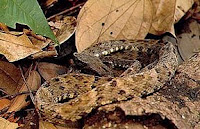 |
| Fer-de-lance (Bothrops atrox) |
n the Amazon, the pit vipers of most concern are the thirty-one species of snake somewhat indiscriminately referred to by the name fer-de-lance or lancehead, all in the genus Bothrops, and all looking very similar, with long bodies and large triangular heads. The lanceheads live in the lowland jungle and average four to six feet in length, although they may grow as long as eight feet. They are generally tan with dark brown diamond-like markings along their sides, and are very well camouflaged. Amazonian pit vipers — as opposed to the colorful coral snakes — have clearly chosen crypsis over warning; it is easy to pass very close to a fer-de-lance without noticing it. Species of Bothrops apparently account for most of the serious snakebites in South America.
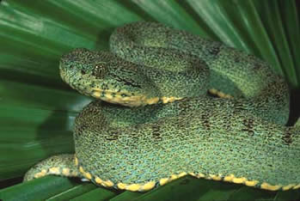 |
| Bothriopsis bilineatus |
Mestizos in the Upper Amazon generally refer to the various Bothrops species as jergón in Quechua or as vibora in Spanish. The Spanish term cascabel, rattle, usually refers to the genus Crotalus, the rattlesnake, which is not found in neotropical environments, but rather in dry habitats such as the savannahs in Guyana. In the Upper Amazon, the term cascabel may be used to refer to juveniles of the genus Bothrops.
There are also two species of so-called forest pit vipers, in the genus Bothriopsis — the two-striped and the speckled, both exclusively arboreal and camouflaged for tree dwelling, with the color green in their pattern. These forest pit vipers are slender snakes, reaching five feet in length, with prehensile tails, usually found coiled around twigs and bushes.
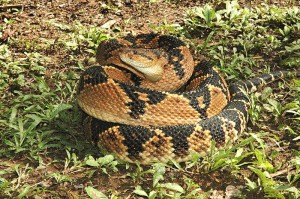 |
| Bushmaster (Lachesis muta) |
Finally, the Amazonian bushmaster or Lachesis muta — the Latin name means silent fate — is the largest pit viper in the world, reaching lengths up to twelve feet. Usually called by the Quechua term shushupi, the bushmaster is found in the lowland rainforest throughout the Amazon. It is generally a coppery tan with dark brown diamond-shaped marks on its back, rather than on its side. It is active at twilight and night, and coils up in the buttresses of large trees, or under roots and logs. After having fed, a bushmaster will remain in place until it has digested its prey, a period of two to four weeks.
Whereas the other neotropical pit vipers bear live young, the bushmaster lays eggs. Because of its length, it can strike over a long distance; because of its large fangs, it can deliver a large dose of venom — probably the largest venom dose of any pit viper. However, bushmasters are very reclusive and therefore rarely encountered; many experienced tropical herpetologists have yet to see their first wild specimen. Thus, few envenomations actually occur, although the fatality rate is reportedly high. I have been unable to find information about the age, physical condition, or treatment of reported fatalities. And it is worth adding that envenomation by any of the Elapidae in the Amazon — primarily fifty-three species of coral snakes in the genus Micruris — is apparently very rare as well.
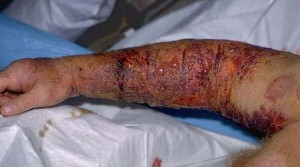 |
| Crotalid envenomation |
Pit viper venom is a complex mixture of enzymes, which varies from species to species, and which is designed to immobilize, kill, and digest the snake’s prey. Thus, pit vipers strike and release quickly; coral snakes, on the other hand, have neurotoxic venom, and small mouths and short fangs, so that they tend instead to hang on and chew. Crotalid venom works by destroying tissue, and is capable of causing significant, sometimes disfiguring local tissue damage; but deaths — at least in the United States, where records are available — are very rare and limited almost entirely to children and the elderly.
Indeed, many pit viper strikes in fact are dry and inject no venom, even when there are fang marks. The snake may have recently injected venom and not yet replenished; it may be because humans are much bigger and give off a lot more heat than the snake’s usual prey, and this throws off the timing of the venom delivery. Additionally, Crotalids can differ significantly in the toxicity of their venom, even within a single litter.
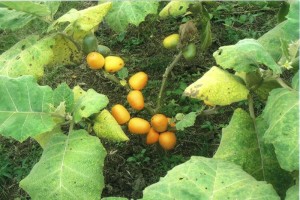 |
| Cocona (Solanum sessiliflorum) |
And pit vipers really want nothing to do with humans. Humans are too big to eat, put out a confusing amount of heat, and are potentially dangerous. As a general rule, you will be bitten only if the snake perceives you as an immediate threat. Snakes hate surprises. That is why pit viper strikes on humans are overwhelmingly on the extremities. In North America, most rattlesnake envenomations are associated with alcohol ingestion on the part of the victim. Rock climbers are at risk for rattlesnake bites because they blindly reach overhead to grab a ledge on which a rattlesnake is sitting in the sun.
Pit viper envenomation can be excruciatingly painful — one expert has said that, on a pain scale of one to ten, rattlesnake bites are an eleven — and the discomfort can last for several days. The envenomated extremity can also become frighteningly ugly, leading to panic in both the patient and the caregiver. Greater or smaller areas of the extremity can turn blue or black, swell alarmingly, and develop large blood blisters. It is altogether an unpleasant experience. There is no question that a Crotalid envenomation is a medical emergency requiring urgent evacuation if possible. However, the first step in treatment is to avoid panic; even without evacuation, most cases result in several days of serious misery and then recovery. More rarely, skin grafts may be necessary. Remember that the fatality rate even for untreated pit viper bites is extremely low.
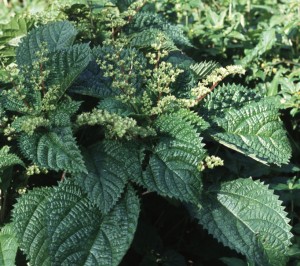 |
| Ishanga blanca, white nettle (Laportea aestuans) |
Mestizos and indigenous peoples in the Upper Amazon use a wide variety of plants to treat snakebite. Ethnobotanists James Duke and Rodolfo Vasquez list twelve genera used for that purpose; Richard Evans Schultes and Robert Raffauf list twenty-nine. My teacher don Roberto Acho Jurama often applies a patarashca, poultice, made of a banana leaf, wrapped around the site of envenomation, filled with the finely chopped tuber of jergón sacha (Dracontium loretense), changed every few hours; he also uses ishanga blanca, white nettle (Laportea aestuans), and cocona (Solanum sessiliflorum), as well as chewed leaves of mapacho, tobacco (Nicotiana rustica), applied directly to the wound. The patient may be given a cold-water infusion of jergón sacha to drink, or cocona fruit boiled with sugar.
Shamans all have their own songs to drive out venom and heal snakebite, usually called, generically, icaro de vibora, pit viper song; remember that icaros generally do not have individual titles in the way that, say, songs do in North America. This icaro is then combined with the definitional triad of mestizo shamanic healing — shacapar, rattling; chupar, sucking; and soplar, blowing tobacco smoke — followed by application of the herbal remedy.
It is hard to judge the effectiveness of any of these remedies. There are few records; there is little long-term follow-up; Crotalid envenomation is frequently self-limiting. There appears to be little empirical basis for allegedly high mortality rates in cases of bushmaster envenomation; a pit viper strike can create a deep puncture wound and severely compromised tissue, so sepsis, especially in the jungle environment, must be a frequent complication. There is evidence that a number of plants traditionally used to treat snakebite — especially those in the family Urticaceae, such as ishanga blanca — have antiinflammatory, immunomodulatory, and thus potentially antivenom activity, which remains to be investigated.

- Previous Post: Video Amazonia Indigena
- Next Post: Learning to Sing
- More Articles Related to: Indigenous Culture, Jungle Survival, Plant Medicine


